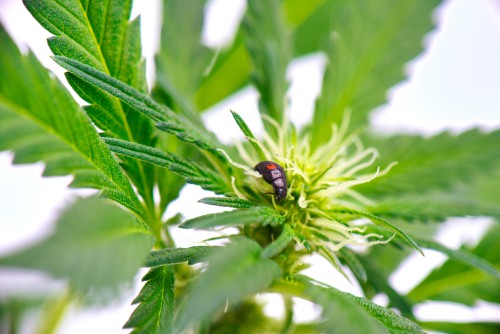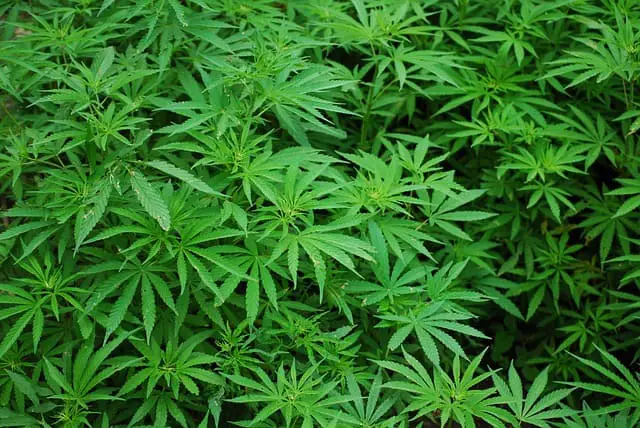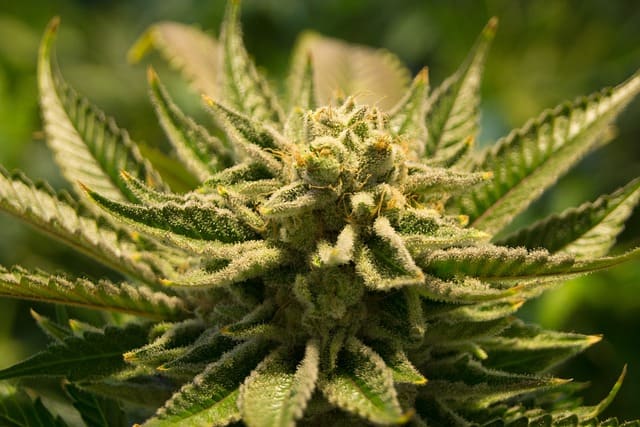Cannabis black spots on leaves can be a sign of various issues that may be affecting your crop. Black spots on fan leaves are one of the most common symptoms of problems in cannabis plants. As such, it is essential to understand how to identify and treat black spots to prevent them from ruining your entire crop.
Identifying black spots on cannabis leaves is crucial to determine the underlying cause of the problem. Black spots can appear in different shapes, sizes, and patterns, and they may be accompanied by other symptoms such as yellowing, wilting, or curling of leaves.
Understanding the different types of black spots and their characteristics can help you diagnose the problem and take the necessary steps to address it.
Common causes of black spots on cannabis leaves include nutrient deficiencies, environmental factors, and pests or diseases. Nutrient deficiencies such as phosphorus, potassium, and magnesium can cause black spots on leaves.
Environmental factors such as high humidity, temperature fluctuations, and poor air circulation can also contribute to black spots. Pests and diseases such as spider mites, thrips, and powdery mildew can cause black spots on cannabis leaves.
Identifying Black Spots on Cannabis Leaves

Cannabis plants are susceptible to a range of issues, including black spots on leaves. These spots can be a sign of various problems, such as nutrient deficiencies, pests, fungi, or viruses. It’s important to identify the cause of the black spots and address the underlying issue to prevent further damage to the plant.
Black spots on cannabis leaves can appear as small or large patches, dots, or streaks. They may be brown, dark brown, black, or even purple in color, depending on the cause.
The spots can occur on any part of the leaf, including the veins, edges, tips, or center. In some cases, the spots may be surrounded by yellow leaves, wilting, or chlorosis (yellowing of the tissue between the veins).
One common cause of black spots on cannabis leaves is a calcium deficiency. Calcium is a vital nutrient for the plant’s cell wall structure and disease resistance.
When the plant lacks calcium, it can’t form strong cell walls, and the tissue may break down, leading to black or brown spots on the leaves. Other symptoms of calcium deficiency may include distorted growth, weak stems, and tip burn.
Another cause of black spots on cannabis leaves is nutrient burn. This occurs when the plant receives too much fertilizer or nutrients, causing the leaves to burn and turn brown or black. Nutrient burn can also cause necrotic (dead) spots on the leaves, as well as brown patches on the tips or edges.
Pests and fungi can also cause black spots on cannabis leaves. For example, spider mites can suck the plant’s sap and leave behind small black dots or streaks on the leaves. Fungi such as powdery mildew or botrytis can also cause black spots, especially if the plant is exposed to high humidity or moisture.
Learn more about plant care from these other related posts:
- How to Treat Black Spots on Palm Leaves
- How to Treat Black Spots on Hibiscus Leaves:
- Can I Eat Mint Leaves with Black Spots?
Cannabis Black Spots on Leaves
When it comes to black spots on cannabis leaves, there are several potential causes. Below are some of the most common:
- Fungal Infections: Fungal infections are one of the most common causes of black spots on cannabis leaves. Fungal spores can easily spread from plant to plant, and once they take hold, they can be difficult to get rid of. Common fungal infections that cause black spots include leaf septoria, anthracnose, and cercospora.
- Pests: Bugs and other pests can also cause black spots on cannabis leaves. Spider mites, in particular, are known to cause black spots, as they suck the sap out of the leaves. Cankers, which are caused by bacteria, can also lead to black spots.
- Nutrient Deficiencies: While less common, nutrient deficiencies can also cause black spots on cannabis leaves. Calcium, for example, is responsible for fighting disease and promoting strong cell wall structure. When calcium is deficient, black/brown spots can appear on cannabis fan leaves.
To prevent black spots on cannabis leaves, it is important to take a proactive approach. This includes:
- Keeping the grow area clean and free of debris
- Using clean, sterilized tools when pruning or trimming
- Providing adequate ventilation and air circulation
- Using fungicides and other treatments as needed to prevent fungal growth and infections
By taking these steps, growers can help prevent black spots on cannabis leaves and keep their plants healthy and thriving.
Nutrient Deficiencies and Black Spots

Cannabis plants require a balanced nutrient profile to grow healthy and produce high-quality buds. Nutrient deficiencies can cause black spots on cannabis leaves, among other symptoms. Here are some common nutrient deficiencies that can cause black spots on cannabis leaves:
- Calcium Deficiency: Calcium is essential for the structural integrity of the plant cell walls. Calcium deficiency can cause black spots on the leaves, as well as stunted growth and weak stems. Adding calcium-rich amendments to the soil or using a calcium supplement can help prevent calcium deficiency.
- Iron Deficiency: Iron is necessary for the production of chlorophyll, which is responsible for the green color of the leaves. Iron deficiency can cause yellowing of the leaves with black spots. Adding iron-rich fertilizers or supplements can help prevent iron deficiency.
- Potassium Deficiency: Potassium is important for the overall health of the plant and helps regulate water uptake and transpiration. Potassium deficiency can cause black spots on the leaves, as well as yellowing and curling of the leaves. Adding potassium-rich fertilizers or supplements can help prevent potassium deficiency.
- Magnesium Deficiency: Magnesium is required for the production of chlorophyll and helps regulate enzyme activity. Magnesium deficiency can cause black spots on the leaves, as well as yellowing and curling of the leaves. Adding magnesium-rich fertilizers or supplements can help prevent magnesium deficiency.
- Phosphorus Deficiency: Phosphorus is essential for the growth and development of the plant, especially during the flowering stage. Phosphorus deficiency can cause black spots on the leaves, as well as stunted growth and weak stems. Adding phosphorus-rich fertilizers or supplements can help prevent phosphorus deficiency.
Nutrient deficiencies can also be caused by nutrient burn, nutrient lockout, or other factors. It is important to monitor the pH levels of the soil or growing medium to ensure proper nutrient uptake. Additionally, over-fertilization can cause nutrient burn, which can lead to black spots on the leaves.
Environmental Factors Contributing to Black Spots
There are several environmental factors that can contribute to black spots on cannabis leaves. These factors can include soil, growth conditions, pH levels, rain, airflow, overwatering, drainage, light burn, heat stress, humidity, overhead watering, and grow lights.
One of the most common causes of black spots on cannabis leaves is a nutrient deficiency, particularly a lack of calcium. Calcium is essential for strong cell wall structure and healthy growth patterns, and when it is deficient, black or brown spots can start to appear on the leaves.
Another factor that can contribute to black spots is overwatering. When plants are overwatered, the roots can become waterlogged, which can lead to poor nutrient uptake and root rot. This, in turn, can cause black spots on the leaves.
Humidity and airflow are also important factors to consider. High humidity levels can create a breeding ground for fungi and bacteria, which can cause black spots on the leaves. Poor airflow can also contribute to the growth of these pathogens, as well as to heat stress and light burn.
Grow lights can also be a contributing factor to black spots on cannabis leaves. If the plants are receiving too much light, or if the lights are too close to the plants, it can cause light burn, which can lead to black spots on the leaves.
In addition, the pH level of the soil can also play a role. If the pH is too high or too low, it can cause nutrient deficiencies and other problems, which can lead to black spots on the leaves.
Preventing and Treating Black Spots on Cannabis Leaves
Black spots on cannabis leaves can be a sign of calcium or magnesium deficiency, diseases, or pests. Preventing and treating black spots on cannabis leaves requires careful attention to the plant’s growth patterns, essential nutrients, and environmental conditions. Here are some tips to help prevent and treat black spots on cannabis leaves:
Preventing Black Spots on Cannabis Leaves

Prevention is the best way to avoid black spots on cannabis leaves. Here are some ways to prevent black spots:
- Use ph-balanced water: Tap water can contain minerals that can affect the plant’s ph levels. Use ph-balanced water to avoid over or under-fertilization.
- Flush the plant: Flushing the plant with plain water can help remove excess nutrients and salts that can cause black spots.
- Use a root rot solution: Root rot can cause black spots. Use a root rot solution to prevent root rot.
- Use a balanced fertilizer: Use a balanced fertilizer to provide essential nutrients to the plant.
- Use disease-resistant seeds: Use disease-resistant seeds to prevent diseases that can cause black spots.
- Maintain proper humidity: High humidity can cause mold and mildew that can cause black spots. Maintain proper humidity levels to prevent mold and mildew growth.
- Use a fungicide: Use a fungicide to prevent and treat fungal diseases that can cause black spots.
- Use ladybugs: Ladybugs can eat pests that can cause black spots.
- Use hydrangeas: Hydrangeas can help lower the ph levels of the soil, preventing black spots.
Treating Black Spots on Cannabis Leaves
If black spots have already appeared on the cannabis leaves, here are some ways to treat them:
- Prune the affected leaves: Pruning the affected leaves can help prevent the spread of the disease or pest.
- Provide essential nutrients: Providing essential nutrients like phosphorus and manganese chelate can help the plant recover from nutrient deficiencies that cause black spots.
- Maintain proper environmental conditions: Maintaining proper environmental conditions like humidity and temperature can help the plant recover from diseases and pests that cause black spots.
- Provide ph-balanced water: Providing ph-balanced water can help the plant recover from nutrient deficiencies that cause black spots.
- Provide proper lighting: Providing proper lighting can help the plant recover from nutrient deficiencies that affect photosynthesis and growth patterns.
- Flush the plant: Flushing the plant with plain water can help remove excess nutrients and salts that can cause black spots.
- Use a fungicide: Use a fungicide to treat fungal diseases that can cause black spots.
- Use ladybugs: Ladybugs can eat pests that can cause black spots.
- Use hydrangeas: Hydrangeas can help lower the ph levels of the soil, preventing black spots.
By following these tips, growers can prevent and treat black spots on cannabis leaves, ensuring healthy plant growth and higher yields.
Cannabis Growth Stages and Black Spots
Cannabis plants go through four primary growth stages from seed to harvest: germination, seedling, vegetative, and flowering. During these stages, the plant undergoes significant changes, and it is essential to monitor the plant’s health to ensure optimal growth.
One common issue that cannabis growers face is black spots on the plant’s foliage. These black spots can be a sign of various problems, including nutrient deficiencies, fungal infections, or pests.
During the vegetative stage, cannabis plants require a lot of nutrients to support their rapid growth. Nutrient deficiencies can cause black spots to appear on the leaves. For example, calcium deficiency can lead to black/brown spots on the cannabis fan leaves. Calcium is responsible for promoting strong cell wall structure and supports healthy growth patterns.
In hydroponics, nutrient deficiencies can occur when the pH of the water is too high or too low, preventing the plant from absorbing essential nutrients. Growers should monitor the pH levels regularly to avoid nutrient deficiencies.
Pests such as spider mites and thrips can also cause black spots on cannabis leaves. These pests damage the leaves, causing them to turn yellow, brown, or black. Growers should inspect their plants regularly and remove any dead or yellowing leaves, as this can prevent pests from spreading.
During the flowering stage, growers should be vigilant for bud rot and mold. These issues can cause black spots to appear on the buds, and if left untreated, can ruin the entire crop. Inspecting under the fan leaves is crucial, as this is where some bugs live.
Conclusion

Black spots on cannabis leaves can be caused by a variety of factors, including nutrient deficiencies, pests, and diseases. It is important for growers to identify the underlying cause of the black spots in order to effectively treat the issue and prevent it from recurring.
One of the most common causes of black spots on cannabis leaves is a calcium deficiency. Calcium is an essential nutrient for cannabis plants, and a deficiency can lead to weakened cell walls and increased susceptibility to disease.
Growers can prevent calcium deficiencies by ensuring that their plants are receiving a balanced nutrient regimen that includes calcium.
Pests such as spider mites and thrips can also cause black spots on cannabis leaves. These pests feed on the plant’s tissue, causing damage that can appear as black spots. Growers can prevent pest infestations by regularly inspecting their plants and using appropriate pest control methods.
Diseases such as powdery mildew and botrytis can also cause black spots on cannabis leaves. These diseases can be difficult to treat, and prevention is key. Growers can prevent the spread of disease by maintaining proper humidity levels, ensuring good air circulation, and promptly removing any infected plant material.
Frequently Asked Question
What causes black spots on cannabis leaves?
Black spots on cannabis leaves can be caused by a variety of factors, including nutrient deficiencies, fungal or bacterial infections, pests, and environmental stress. Some of the most common causes of black spots on cannabis leaves include calcium deficiency, leaf septoria, and thrips.
How do I treat black spots on my cannabis leaves?
The treatment for black spots on cannabis leaves depends on the underlying cause of the issue. If the black spots are caused by a fungal or bacterial infection, it is important to remove the infected leaves and treat the plant with an appropriate fungicide or bactericide.
If the black spots are caused by a nutrient deficiency, it is important to adjust the plant’s nutrient regimen accordingly. In some cases, environmental stress or pest infestations may be the cause of black spots on cannabis leaves, in which case it is important to address the root cause of the issue to prevent further damage.
Are black spots on cannabis leaves harmful?
Black spots on cannabis leaves can be harmful to the plant if left untreated, as they can lead to reduced yield, stunted growth, and even death. In addition, if the black spots are caused by a fungal or bacterial infection, they may be contagious and can spread to other plants in the grow room.
What is the difference between leaf septoria and black spots on cannabis leaves?
Leaf septoria is a fungal infection that causes small, brown spots with yellow halos on cannabis leaves. Black spots on cannabis leaves, on the other hand, can be caused by a variety of factors, including nutrient deficiencies, fungal or bacterial infections, pests, and environmental stress.
While leaf septoria can be one cause of black spots on cannabis leaves, it is not the only one.
Can thrips cause black spots on cannabis leaves?
Yes, thrips can cause black spots on cannabis leaves. Thrips are small, winged insects that feed on the sap of cannabis plants. As they feed, they can cause damage to the leaves, including the formation of black spots.
What nutrient deficiencies can cause black spots on cannabis leaves?
Calcium deficiency is one of the most common nutrient deficiencies that can cause black spots on cannabis leaves.
Other nutrient deficiencies, such as magnesium, sulfur, and potassium, can also cause black spots on cannabis leaves. It is important to maintain a balanced nutrient regimen to prevent nutrient deficiencies and ensure healthy plant growth.

Hey, I’m Lisa and I’ve been an avid gardener for over 30 years. I love writing, talking and living in the garden! Feel free to connect with me on my socials below


